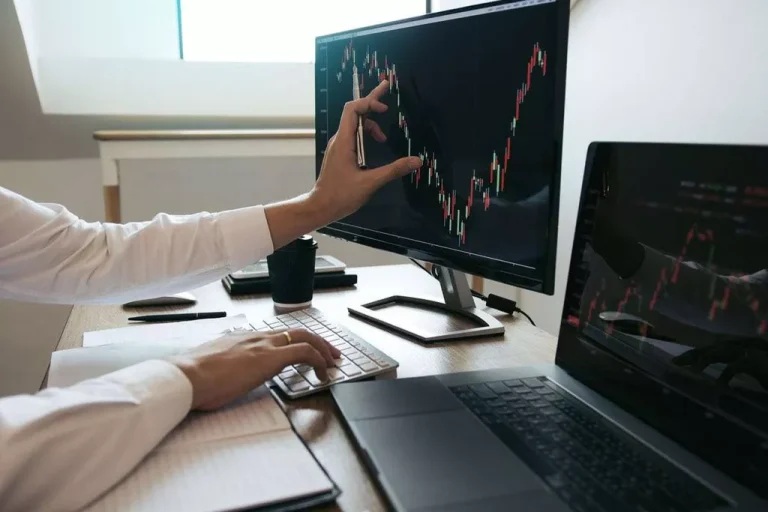Content
To illustrate how this works, let’s suppose the bid of Company XYZ stands at $99.00 and the ask sits at $100.00, creating a spread of $1. An investor wants to purchase shares of XYZ at the mid-point of $99.50. That order goes from investor to brokerage and then reroutes to a market maker. The market maker may https://www.xcritical.com/ offer to sell at $99.50, but not before purchasing those shares at $99.40, pocketing the difference of .10 cents in the process. So while the investor recognizes some price improvement, they’re not receiving the best execution, losing value overall. The Securities and Exchange Commission (SEC) requires brokers to disclose the compensation they receive for directing customer orders to market makers.

What Is Payment for Order Flow (PFOF)?
The bid ask spread is a bracket, representing the highest price buyers pfof meaning are willing to pay for a stock, the bid, and the lowest price sellers are willing to sell that stock, the ask. Depending on the fluctuations of supply and demand, it represents the price of a stock at any given time. As trades are made, data flows from public exchanges and aggregates into a listing known as the NBBO, or National Best Bid and Offer.
Payment for order flow (PFOF) and why it matters to investors

Many market makers are brokerage houses that provide trading services for investors. The SEC has launched a plan to address stock trading rules for the retail trading market. Through this, the SEC aims to increase competition in the commission-free brokerage industry and prevent small-time investors from overpaying for stocks. In turn, the market makers reward the brokerages with a profit worth a fraction of the trade.

How do I get the best order execution?
You assume full responsibility for any trading decisions you make based upon the market data provided, and Public is not liable for any loss caused directly or indirectly by your use of such information. Market data is provided solely for informational and/or educational purposes only. It is not intended as a recommendation and does not represent a solicitation or an offer to buy or sell any particular security. Banking services and bank accounts are offered by Jiko Bank, a division of Mid-Central National Bank.JSI and Jiko Bank are not affiliated with Public Holdings, Inc. (“Public”) or any of its subsidiaries. You should consult your legal, tax, or financial advisors before making any financial decisions. This material is not intended as a recommendation, offer, or solicitation to purchase or sell securities, open a brokerage account, or engage in any investment strategy.
Get stock recommendations, portfolio guidance, and more from The Motley Fool’s premium services. Buying one national currency while selling another is known as forex trading. Public decided to stop accepting payment for order flow to remove that conflict of interest from our business.
By mandating this disclosure, the reports mandated by 606(a) aim to enhance the integrity of the market and protect investor interests. This guide ranks the top brokers of 2024 that don’t accept PFOF, highlighting those committed to transparent, client-first order routing. By eliminating revenue from market makers, these firms raise the bar for execution quality, potentially giving active traders a pricing advantage. For investors who value optimal trade execution, these brokers represent a superior choice.
Whether an entity or individual, market makers are obligated to provide bids and offers for securities—that is, to make markets—so that markets retain some degree of liquidity and investors can continue to buy and sell. How the industry interprets the definition of PFOF is subject to much debate. For example, with options trading, if you think about “payment” more broadly as “profiting,” then all brokers accept PFOF for options.
PFOF is the compensation a broker receives from a market maker in return for directing orders to a particular destination for execution. Essentially the market maker is sharing a portion of the profits they earn from making a market with the broker who routes the order to them. This payment typically amounts to a fraction of a penny per share on equity securities. Industry observers have said that for retail investors weighing the trade-off between low trading costs versus good prices, it may come down to the size of their trades.
People did that, even if those people lost money on PFOF (not to mention a volatile market). In the first half of 2020, Robinhood grossed $271.2 million from PFOF alone. The company settled with the SEC later that year, agreeing to pay $65 million over misleading clients on PFOF revenue and more. A variety of factors come into play with your broker’s ability to provide quality order execution. If you’re trading large amounts of shares frequently, best execution is critical. Interactive Brokers’ sophisticated order routing algorithms make the broker a favorite for professionals.
Direct routing to the exchanges is more expensive, which is why were turning what used to be a revenue stream (ahemPFOF) into a cost center. And forgoing PFOF allows us to promote our core values of a transparent investing environment, as the practice can go against the positive impact that many investors have in mind when they envision a better world. According to the NYSE, a market maker is an “ETP holder or firm that has registered” to trade securities with the exchange. Making a market signals a willingness to buy and sell the securities of a certain set of companies to broker-dealer firms that are members of an exchange. Each market maker displays buy and sell quotations (two-sided markets) for a guaranteed number of shares. Once the market maker receives an order from a buyer, they immediately sell their position of shares from their own inventory.
SEC chair Gary Gensler is bringing attention to PFOF and its pitfalls, especially for retail investors using commission-free brokerages. Order execution quality is how much you pay or receive on a trade compared to the nationally published quote on a security, called the National Best Bid and Offer (NBBO). If you buy a stock less than the current offer, you are getting a high quality fill, and the more you save, the higher quality it is. If you receive more per share than the published bid price, you are getting a high quality fill. When you push the “submit order” button to trade, your order won’t go directly to an exchange.
While PFOF may not be serving these new market participants perfectly, without it, many would not be market participants at all. Retail brokerages, in turn, use the rebates they collect to offer customers lower — or often zero — trading fees. You can also send limit orders (orders that must be filled at a specific price) that are “inside” the quoted best bid and offer.
- This material is not intended as a recommendation, offer, or solicitation to purchase or sell securities, open a brokerage account, or engage in any investment strategy.
- Ratings are not recommendations to purchase, hold, or sell securities, and they do not address the market value of securities or their suitability for investment purposes.
- SoFi has no control over the content, products or services offered nor the security or privacy of information transmitted to others via their website.
- Apex Clearing and Public Investing receive administrative fees for operating this program, which reduce the amount of interest paid on swept cash.
- The DMM must also set the opening price for the stock each morning, which can differ from the previous day’s closing price based on after-hours news and events.
- For instance, market makers can package orders together and front run them, use the added liquidity to increase spread arbitrage, and even take the other side of the retail order.
The New York Stock Exchange has actual human “specialists” on the floor that serve this function. In contrast, the fully-electronic Nasdaq exchange has around 14 market makers for each security, all competing with each other to provide liquidity. Meanwhile, brokers are benefitting because they’re getting paid to execute orders for customers instead of paying an exchange to do so. And customers can be happy that they get a better price than they were hoping to get. The options market also tends to be more lucrative for the brokerage firm and market maker. That’s because options contracts trading is more illiquid, resulting in chunkier spreads for the market maker.
All you need to do is open up a brokerage account with a broker that does not accept PFOF. These brokerages will either route your orders through market makers that don’t pay for order flow or give you direct market access. And since the retail investor has far more access to relevant information today, these PFOF schemes can also expose these market makers to increased risk (i.e r/wallstreetbets GME pump). Brokers receive payments for order flow from third parties on either a per-share or per-dollar basis. PFOF transfers some of the market makers’ profits to the brokerage, but market makers realize profits from the arrangement as well. For the past 20 or so years, the spreads for most securities have continued to narrow.
Latest figure for the total market capitalization of domestic companies listed on exchanges in the U.S. Other major brokerages earning off of PFOF include Charles Schwab, TD Ameritrade, and E-Trade. Together with Robinhood, these four institutions earned a collective $2.5 billion on PFOF in 2020. Steven Hatzakis is the Global Director of Research for ForexBrokers.com.
